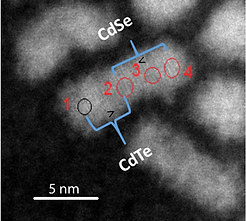




2. Photochemistry and photophysics of Semiconductor quantum dots
1. Crystal Structure Dependent Luminescence of QDs:
2. Indium Phosphide QDs for Photoinduced Energy Transfer:
3. Deep Trap State in InP and Shallow Trap States in CdSe:
Crystal Structure Dependent Luminescence of QDs:
Optimizing the shell thickness of core-shell quantum dots (QDs), which can suppress the undesired electron-transfer process and provide maximum emission yield is crucial for the design of luminescence materials. We have developed methodologies for obtaining quantitative information on the optimum shell thickness ZnS overcoated on CdSe for various luminescence applications. It is reported that the cubic zinc blende CdSe (Zb-CdSe) exhibited excellent photostability and high luminescence quantum yield compared to hexagonal wurtzite CdSe. However, the reason for the crystal-dependent luminescence properties of CdSe was not understood. Our studies have revealed a fundamentally important finding that the surface of Zb-CdSe is rich with Cd2+ ions, which leads to the formation of Type I core-shell nanostructures responsible for the enhanced luminescence.
-
An Approach for Optimizing the Shell Thickness of Core-shell Quantum Dots Using Photoinduced Charge Transfer.
Vinayakan, R.; Shanmugapriya, T.; Nair, P. V.; Ramamurthy, P.; Thomas, K. G.,
J. Phys. Chem. C 2007, 111, 10146-10149.
-
Synthesis of CdS Nanorods and Nanospheres: Shape Tuning by the Controlled Addition of a Sulfide Precursor at Room Temperature.
Shanmugapriya, T.; Vinayakan, R.; Thomas, K. G.; Ramamurthy, P.,
CrystEngComm 2011, 13, 2340-2345.
-
Luminescence Properties of CdSe Quantum Dots: Role of Crystal Structure and Surface Composition.
Subila, K. B.; Kishore Kumar, G.; Shivaprasad, S. M.; Thomas, K. G.,
J. Phys. Chem. Lett. 2013, 4, 2774-2779.
-
CdSe–CdTe Heterojunction Nanorods: Role of CdTe Segment in Modulating the Charge Transfer Processes.
Subila, K. B.; Sandeep, K.; Thomas, E. M.; Ghatak, J.; Shivaprasad, S. M.; Thomas, K. G., ACS Omega 2017, 2, 5150-5158.
Indium Phosphide QDs for Photoinduced Energy Transfer:
We have demonstrated that InP is a versatile and environmentally friendly material for energy transfer applications, meeting various photophysical requirements. The structural changes in peptide monomer, on addition of heparin are further monitored at nanomolar concentrations through the inhibition of energy transfer from InP quantum dots to rhodamine dye.
-
InP Quantum Dots: An Environmentally Friendly Material with Resonance Energy Transfer Requisites.
Thomas, A.; Nair, P. V.; Thomas, K. G.,
J. Phys. Chem. C 2014, 118, 3838-3845.
-
InP Quantum Dots: Probing the Active Domain of Tau Peptide Using Energy Transfer. Thirunavukkuarasu, S.; George, A.; Thomas, A.; Thomas, A.; Vijayan, V.; Thomas, K. G., J. Phys. Chem. C 2018, 122, 14168-14176.
Deep Trap State in InP and Shallow Trap States in CdSe:
It is theoretically proposed that the degree of covalency in QDs influences the depth of surface trap states, which in turn affects the charge recombination process in hybrid systems. We have experimentally investigated these aspects by taking relatively ionic cadmium selenide (CdSe) QDs with shallow trap states and covalent indium phosphide (InP) QDs having deep trap states as examples, using a viologen derivative as an electron acceptor. Time-resolved spectroscopic studies showed the presence of deep hole trap states in InP QDs which retard the charge recombination to hundreds of milliseconds and to even seconds. In contrast, charge recombination in CdSe with shallow trap states occurs in picosecond time scale.
-
How Trap States Affect Charge Carrier Dynamics of CdSe and InP Quantum Dots: Visualization through Complexation with Viologen.
Thomas, A.; Sandeep, K.; Somasundaran, S. M.; Thomas, K. G.,
ACS Energy Lett. 2018, 3, 2368-2375.



